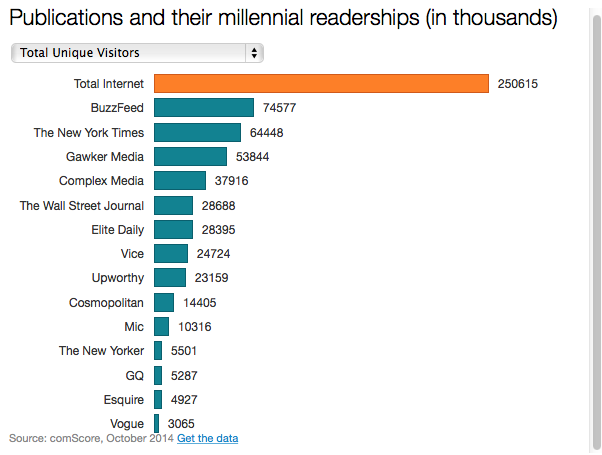Marketers definitely have an interest when it comes to going after millennials, since there are so many ways to reach that audience via media. They continue to be the largest demographic in the United States, accounting for nearly a third of the general population.
However, there are some things that can be learned from the media consumption that millennials have gone through this year, according to a report from Digiday. The five basic principles are broken down below:
Traditional publications are still popular
Taking information from comScore, Digiday has broken down the data for certain media sites, indicating that millennials still have a high interest in traditional publications, such as The New York Times and the Wall Street Journal.
According to the numbers (revealed in a chart below), The New York Times still accounts for more than 64 million unique visitors across desktop and mobile platforms for the month of October alone, with 20 million millennials included. Meanwhile, Nice has managed to gain 25 million total visitors, with 3/5 of that audience being millennials. Out of all the sites, however, Buzzfeed remains the most popular, with 74 million visitors — 39 million in the millennial age. That’s more than half.

Online Video Is Viewed Often
Nielsen has reported that millennial males enjoy watching online video to a great extent, to the tune of 2 hours and 15 minutes on a weekly basis. However, when it comes to watching weekly television, they only tune in 20 hours each week, compared to 23 hours for millennial females and 28 hours for Gen X males.
Meanwhile, African-American millennial makes watch both more traditional television (33 hours) and online video (three hours) than the general average, while Asian-American males watch less television (11.5 hours) and more web video (almost four hours).
Socially Responsible Brands Are More Highly Accepted
An October 2014 report from The White House’s Council of Economic Advisors shows that 92 percent of millennial employees feel that they contribute to a company that has a positive effect on the world overall, between such causes as global warming and animal rights.
They feel that social responsibility can have a ripple effect with certain brand purchases, with millennials being three times as likely to wear clothes from socially conscious brands over those that are more luxury-based. Meanwhile, four in ten are willing to pay more for products and brands with an environmental impact. That number’s even higher in China and India, as 65 percent and 60 percent, respectively, of millennials say they’re willing to fork over more money for eco-friendly products.
Millennials Love Amazon, But Not TV Networks
Amazon is one of millennials’ most loved brands, according to youth insights consultant group Voxburner. A recent survey of 3,000 millennials in the United Kingdom showed that 94 percent have positive feelings for the web giant, with YouTube and Google closely behind with 93 percent. “To be a successful youth brand, you must be able to do at least one of three things: make young people’s lives easier, more fun or save them money,” said Simon Eder, the founder of Voxburner. “It’s amazing how many brands are ticking these criteria.”
Those three sites, as well as Facebook, rank amongst the top four millennial brands altogether, while Amazon is considered the top site for non-millennials. However, broadcast networks show a vast difference between the two audiences. All four major networks show top-10 brand placement with non-millennials, but are nowhere in the top ten list for millennials.
Facebook and YouTube Are Favorites On Phones
comScore data shows that Facebook continues to be a top draw for millennials on mobile phones, with 47 million unique visitors for last month. YouTube is closely behind with over 36 million visitors, while Pandora is in third place with 33 million users. Meanwhile, lower on the list, Snapchat has 17 million unique visitors, showing some growth over the previous year (by 67 percent), but still needing a ways to go to catch up to the “big boys.”
Indeed, millennials will just get bigger with 2015, at least in some marketers’ eyes.

